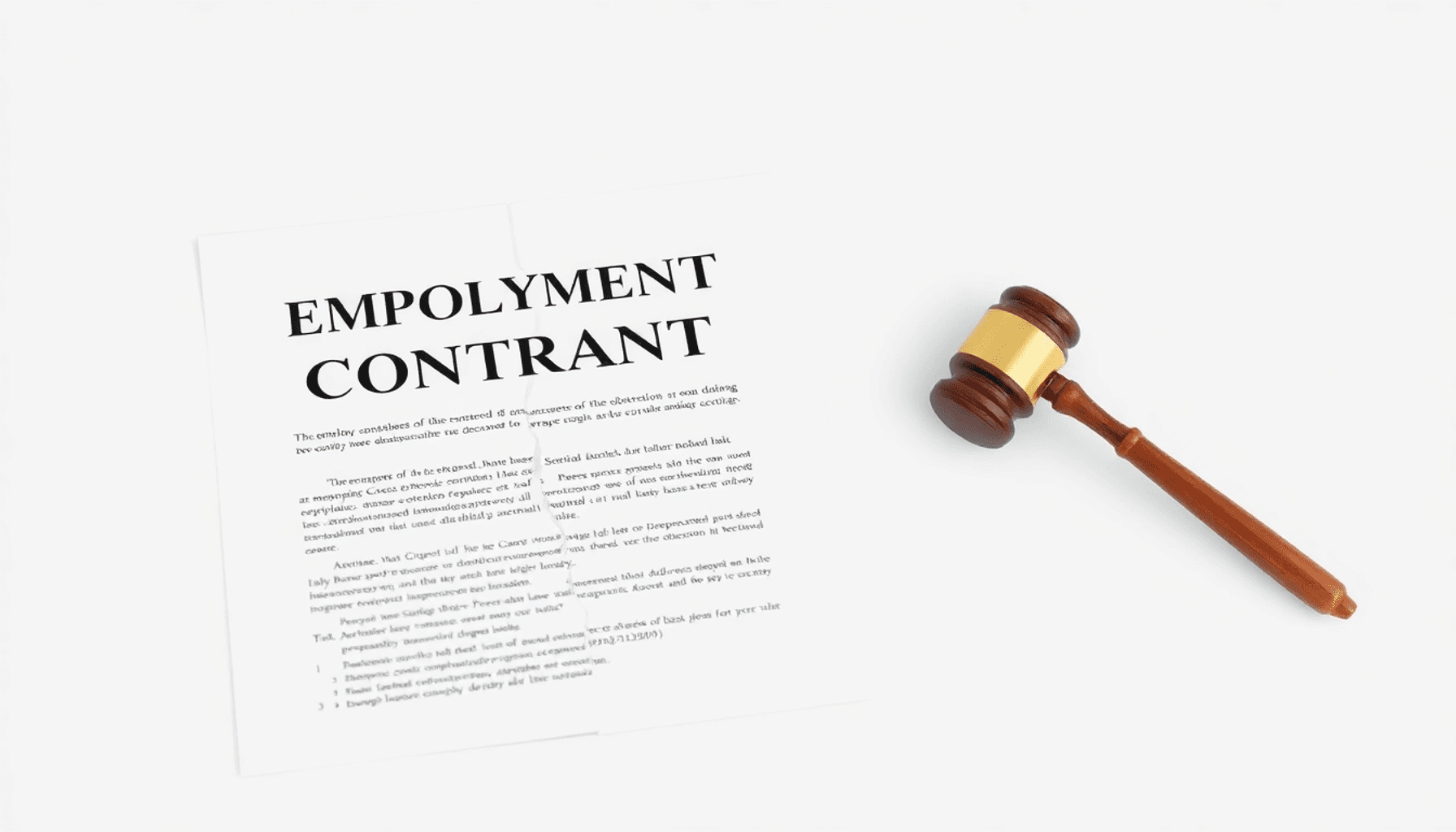Introduction
Accord and satisfaction is a legal concept within contract law that involves an agreement to settle a dispute or debt by accepting an alternative performance rather than fulfilling the original obligation. This process hinges on two key components: the “accord,” which is the new agreement, and “satisfaction,” the fulfillment of that agreement. Its significance lies in its ability to resolve disputes efficiently.
This article delves into:
- Understanding accord and satisfaction
- Applicability scenarios
- Key elements for valid claims
- Advantages and disadvantages
- Legal precedents
- Practical applications beyond cash settlements
Understanding Accord and Satisfaction
Accord and satisfaction are important concepts in contract law, often used to resolve disputes through legal agreements.
Key Concepts
- Accord: This is a new agreement made between disputing parties. It involves an alternative performance that differs from the original contractual obligations. For example, if a party owes a debt but disputes the amount, they might propose paying a reduced sum as part of an accord.
- Satisfaction: This refers to the execution of the agreed-upon alternative performance. Once the debtor fulfills the conditions set out in the accord, satisfaction is achieved, thereby suspending the enforcement of the original contract.
How It Works
These two elements work together within legal agreements to facilitate dispute resolution:
- The accord acts as a substitute for the original obligation.
- Satisfaction ensures that this substitute performance is carried out effectively.
Why It Matters
The role of accord and satisfaction is significant in resolving disputes:
- By accepting an alternative performance, both parties can reach a mutually agreeable solution without going to court.
- This approach is especially useful in situations involving debts that aren’t clearly defined or where exact amounts owed are uncertain.
Example:
In a construction dispute where a contractor’s work quality is contested, the homeowner and contractor might agree on a lesser payment than initially billed. The homeowner’s payment under this new agreement constitutes satisfaction, thus settling the dispute amicably.
When is Accord and Satisfaction Applicable?
Accord and satisfaction often come into play in various dispute scenarios, especially those involving unliquidated debts. These are debts where the exact amount owed is uncertain or disputed. Such situations often require alternative solutions to avoid lengthy legal battles.
Common Situations
- Construction Disputes: In construction contracts, disputes may arise over the quality of work performed or materials used. For example, if a contractor’s work is deemed substandard by the homeowner, an accord and satisfaction might be reached where the contractor agrees to accept a lower payment than initially agreed upon.
- Service Contracts: Similar issues can occur in service contracts, such as consulting or maintenance agreements. If a client disputes the value or effectiveness of services provided, they might negotiate a reduced fee as part of an accord and satisfaction.
- Uncertain Amounts Owed: Cases involving unliquidated debts are prime candidates for accord and satisfaction. For instance:
- A business facing financial difficulties might negotiate with its creditors to accept partial payments or alternative forms of compensation.
- A landlord and tenant may resolve a dispute over unpaid rent by agreeing to a lesser amount if there is ambiguity regarding the total sum due.
Importance in Debt Resolution
Accord and satisfaction serve as crucial tools for resolving disputes where the precise amount owed is unclear. By allowing parties to settle on an alternative performance instead of the original obligation, it provides a practical approach to debt resolution. This method not only reduces potential conflicts but also enables quicker settlements, thereby saving resources and maintaining relationships between parties involved.
Key Elements for Validity of Accord and Satisfaction Claims
Establishing a valid accord and satisfaction claim requires meeting specific key elements. These elements ensure that the agreement is legally binding and enforceable.
Requirements for Accord and Satisfaction Claims
1. Sufficient Claim on the Original Contract
The party asserting an accord and satisfaction must have a sufficient claim on the original contract. This means there should be a bona fide dispute or an unliquidated debt where the amount owed is uncertain.
Example: In construction disputes, if a contractor claims additional payment for extra work, the homeowner might dispute this amount. Here, establishing a sufficient claim on the original contract is crucial.
2. Clear Settlement Agreement
There must be a clear and unequivocal agreement between the parties to settle the dispute or debt. This agreement constitutes the “accord.”
Key Aspect: The terms of the settlement must be explicit and agreed upon by both parties to avoid any ambiguity which could lead to further disputes.
3. Fulfillment of the Agreement (Satisfaction)
The performance of the new agreement by one party, known as “satisfaction,” is essential to discharge the original obligation.
Example: If a debtor agrees to provide goods instead of cash to settle a debt, delivering those goods constitutes satisfaction.
Importance of Clear Terms
- Clarity in settlement agreements prevents misunderstandings and ensures both parties are aware of their obligations.
- Explicit terms protect against future legal challenges by clearly defining what constitutes fulfillment.
Legal Precedents
Legal precedents underscore these elements, emphasizing their necessity for enforcing accord and satisfaction claims effectively.
Advantages of Using Accord and Satisfaction in Dispute Resolutions
1. Quick Resolution and Cost-Effective Solution
Accord and satisfaction offers significant benefits in dispute resolution, primarily due to its ability to provide a quick resolution. By agreeing on an alternative performance, parties can settle disputes efficiently without the prolonged timeline often associated with litigation. This expedites the resolution process, allowing both parties to move forward without enduring lengthy legal battles.
2. Litigation Avoidance
Another key advantage is the avoidance of litigation. Traditional litigation processes are not only time-consuming but also costly. Legal fees, court costs, and other related expenses can quickly accumulate, making litigation an expensive endeavor. Accord and satisfaction, by contrast, eliminates these costs by resolving disputes outside the courtroom.
3. Real-World Examples Illustrating Advantages
For instance:
- In construction disputes, where the quality or extent of work is contested, parties might agree on a reduced payment or additional work rather than pursuing costly legal action.
- Service contract disagreements can be settled through accord and satisfaction by offering alternative services or partial payments, saving both parties from potential financial strain and maintaining business relationships.
In summary, accord and satisfaction serves as a practical mechanism for achieving swift, cost-effective dispute resolutions while avoiding the complexities and financial burdens of traditional litigation.
Drawbacks of Accord and Satisfaction Claims
Accord and satisfaction, while beneficial in many scenarios, is not without its limitations. One significant drawback is the potential for settlement dissatisfaction. Parties may agree to a lesser amount than originally owed, leading to feelings of discontent if the settlement does not meet their expectations or cover the perceived full value of the original obligation.
Several limitations are inherent in this legal concept:
- Incomplete Satisfaction: The agreed-upon performance may fall short of what one party believes they are entitled to under the original contract, resulting in ongoing dissatisfaction.
- Risk of Coercion: In some cases, one party might feel coerced into accepting an accord out of necessity, rather than mutual agreement.
Another critical aspect is that once an accord and satisfaction is executed, it generally bars any future claims related to that specific debt. This means that:
- Upon execution, any subsequent claims arising from the original contract are prohibited.
- This precludes parties from seeking additional compensation or redress for issues that may emerge later.
These factors underscore that while accord and satisfaction can expedite dispute resolution, it demands careful consideration of potential long-term consequences and the adequacy of settlement terms.
Legal Precedents Shaping the Understanding of Accord and Satisfaction
An in-depth examination of legal precedents reveals the nuanced interpretations and applications of accord and satisfaction within contract law. Key cases such as Foakes v Beer and Pinnel’s Case have significantly influenced the legal landscape.
Foakes v Beer
The Foakes v Beer case is pivotal in understanding partial payments’ acceptance under accord and satisfaction. Dr. Foakes owed Mrs. Beer a judgment debt, and both parties agreed that Dr. Foakes would repay in installments without accruing interest. Later, Mrs. Beer sued for the interest, arguing that her agreement to forego it was not legally binding due to lack of consideration. The House of Lords ruled in favor of Mrs. Beer, establishing that a promise to accept less than the full amount owed does not discharge the debt unless supported by new consideration. This precedent underscores the necessity for additional consideration in partial payment agreements.
Pinnel’s Case
Dating back to 1602, Pinnel’s Case introduced another crucial doctrine affecting accord and satisfaction. It established the principle that payment of a lesser sum on the day of performance cannot satisfy a greater debt unless accompanied by some additional form of consideration, such as early payment or goods instead of cash. This ruling emphasized that an accord must be backed by new value to be legally enforceable.
These cases illustrate the complexities surrounding accord and satisfaction, particularly regarding what constitutes adequate consideration for a binding agreement.
Practical Applications Beyond Cash Settlements
Accord and satisfaction go beyond just cash settlements, offering flexibility through alternative compensation forms such as goods or services. This adaptability enables parties to tailor solutions that meet their specific needs. For instance, a supplier may agree to accept a batch of products instead of monetary payment to resolve a dispute with a retailer.
Real-Life Applications
Several scenarios illustrate this concept:
- Service Exchanges: A contractor might perform additional work or offer maintenance services as part of an accord.
- Product Substitutions: A manufacturer could provide extra units or premium models to settle disputes over defective goods.
- Barter Arrangements: Businesses might trade excess inventory or services to offset outstanding debts.
Negotiation Strategies
Effective negotiation is crucial for successful accord and satisfaction agreements. Key strategies include:
- Clear Communication: Ensure all parties understand the terms and conditions clearly.
- Valuation Agreement: Establish a mutually acceptable valuation for the alternative compensation.
- Documentation: Keep detailed records to avoid future disputes, outlining the agreement and performance criteria.
Employing these strategies can facilitate smoother negotiations and lead to more satisfactory outcomes for both parties involved.
Conclusion
Accord and satisfaction are important in contract law, offering a practical way to resolve disputes. It’s essential to weigh its benefits, like faster resolutions and cost savings, against potential drawbacks, such as dissatisfaction with settlements, for effective use.
Readers should think about using this legal concept strategically when suitable, taking advantage of its benefits for efficient dispute resolution.




